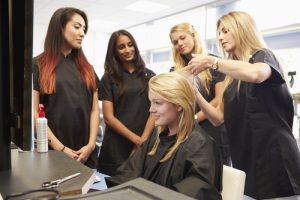

A professional hairdresser is someone who provides haircut, style, and color to clients. He or she is someone highly skilled in many different processes and techniques related to styling hair. This includes cutting, coloring, curling, perming, highlighting, drying, braiding, and more.
Getting familiar with various types of hairstyles and knowing what styles are on trend, and then incorporating them into each individual client’s hair type and facial features is an essential trait to have for any successful and professional hairdresser.
Clients usually come to a professional hairdresser with an exact idea of what hairstyle they want. In other cases, some clients have no clue at all on what style would suit them.
Either way, they should be able to trust a professional hairdresser to steer them in the right direction. A professional should be knowledgeable to create a style for their clients that meet their expectations.
Training Required for a Professional Hairdresser
Typically, hairstylists hone their craft by completing a cosmetology degree. They do this by a vocational program or cosmetology school. Cosmetology program requirements also differ by state. Thus, it’s essential to know your jurisdiction requirements before attending and completing a training course.

In the United States, professional hairdressers must earn a license before they can practice. And to obtain a hairdresser license, a cosmetology training program must be completed. These programs can take anywhere from half a year to 18 months.
Cosmetology schools and vocational programs train students on how to cut, color, and style hair. These are just the fundamental teachings. As they delve deeper into the course, more various techniques are taught.
Students learn by working on real clients’ hairstyles. These are people who agree to have their hair done by students for discounted rates. Through this tried-and-tested process of learning how to style hair, students learn the hairstyling skills needed to earn their license.
Also, this process allows would-be hairstylists to learn how to communicate with customers properly. Clear communication between a hairstylist and a client is vital. This ensures that a style is set to meet the preferences and needs of each individual client.
Apprenticeship Training
Some states grant cosmetology training through an apprenticeship. Hairstylist apprentices are trained under the supervision of a professional and licensed hairdresser. This arrangement is essentially a paid training program.
Apprentices are paid for doing the work as they learn the craft. These programs can usually last for up to two years. Apprentices may also be required to complete a set amount of classroom training hours while doing an apprenticeship.

After completing an apprenticeship or graduating from cosmetology school, professional hairdressers can start the process of applying for their state license. Only after earning the license can they begin working.
Many stylists pursue additional training or attend seminars to learn about the latest in the beauty and styling industry. Cosmetology schools and hair academies offer advanced training and education for licensed and professional hairdressers.
Additional braining and styling techniques or new trends in coloring are some of the skills you can learn by attending advanced training.
Licensure Requirements for a Professional Hairdresser
As we mentioned above, all states require stylists to have a license before offering their services to clients. However, the requirements to maintain a license may vary by state. Generally, a professional stylist must complete a high school diploma, graduate from a state-approved apprenticeship or cosmetology program, and pass a licensure examination.
In some states, hairstylists are also licensed as cosmetologists. In other states, don’t categorize their hairstylists in the same description as cosmetologists.
As you know, cosmetologists are not limited to hairdressing and hairstyling techniques. Cosmetologists are also trained to do makeup applications, nail care, and skincare just as much as they are skilled to do hairstyling.
In states where hairstylists must also be trained and licensed as cosmetologists, up to 2,000 hours of training must be completed. States that also offer independent stylist license require lesser instruction hours.
More Than Just Hair
Students attending cosmetology programs can also learn other facets of the beauty industry. Skincare, nail care, makeup application, waxing, are some of the other skills they can learn. These are parts of a developed cosmetology curriculum.
As students learn about these skills, they can also familiarize themselves with color theory, shaping nails, facial structure, dermatology basics, and manicures and pedicures.


